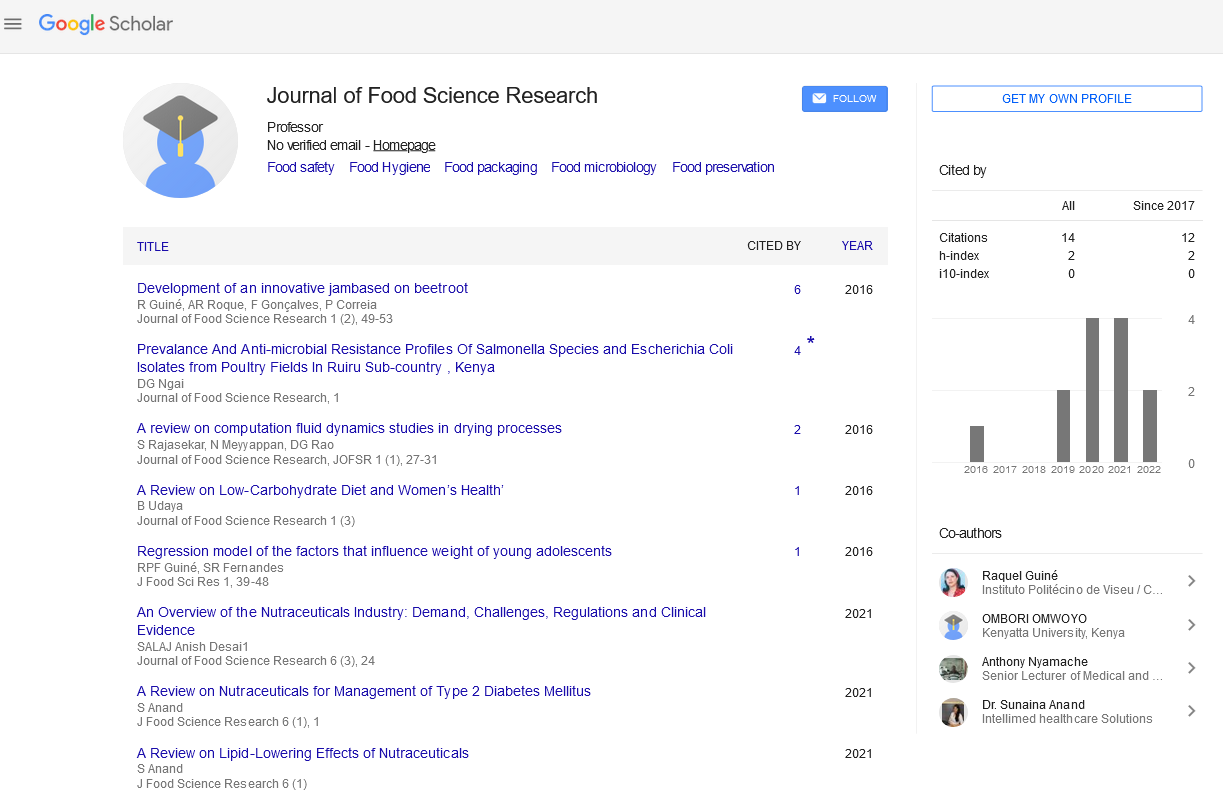Short commentary
, Volume: 7( 1) DOI: 10.37532/ J Food Sci Res.2022.07.95A Systematic Review and Meta-Analysis of Tele health Methods for Delivering Dietary Interventions to Adults with Chronic Disease
Brereton James*
Department of Agricultural Chemistry and Food Science, Universidad Autónoma de Madrid, Madrid, Spain
*Corresponding Author:Brereton James
Department of Agricultural Chemistry and Food Science, Universidad Autónoma de Madrid, Madrid, Spain
Email: breretonjames@gmail.com
Received date: January 28, 2022, Manuscript No. TSFSR-21-59730; Editor assigned date: January 31, 2022, Pre QC No. TSFSR-21-59730(PQ); Reviewed date: February 10, 2022, QC No. TSFSR-21-59730; Revised date: February 21, 2022, Manuscript No: TSFSR-21-59730(R); Published date: February 28, 2022, DOI: 10.37532/ J Food Sci Res.2022.07.95.
Citation: James B. A Systematic Review and Meta-Analysis of Tele Health Methods for Delivering Dietary Interventions to Adults with Chronic Disease. J Food Sci Res. 7(1):95 @ copy; 2022 Trade Science Inc.
Abstract
Introduction
Chronic diseases are the main cause of death worldwide, accounting for more than 68% of all deaths. Obesity, heart disease, diabetes mellitus, hypertension, stroke, and kidney disease are all chronic diseases with a complex aetiology, which is often nutrition linked. For the management of chronic diseases, self-management and the adoption of a healthy lifestyle, such as improved food habits, increased physical activity, and other health-related behaviors (e.g. smoking cessation), are considered crucial. Standard chronic illness care models, on the other hand, are only followed by a small percent-age of patients for a variety of reasons, including poor compliance and a high patient burden. This means that traditional care methods will not be able to help people maintain healthy eating habits in the long run. Individuals with various risk factors for Cardiovascular Disease (CVD) and other chronic diseases have been found to have higher rates of Face-to-Face (FTF) consultation nonattendance. Appointment non-attendance can be caused by patient-centered impediments such as inadequate transportation and geographical isolation, working hours, and forgetfulness about appointments. Administrative errors, inadequate access to clinic facilities, limited parking, and unsuitable clinic working hours are other health care hurdles that can obstruct access to standard FTF care.
Tele-health technologies may be used to give education and self-management support to help people make and keep healthy lifestyle changes, and they have a number of benefits over traditional FTF care models. Tele-health tactics can help patients with chronic diseases improve their eating habits and are flexible in terms of time and place, allowing for intense interventions that aren’t always possible with standard care models. According to the World Health Organization, tele-health refers to the use of information and communication technologies to exchange health information to deliverhealth care services synchronously and/or asynchronously from a distance. A tele-health lifestyle intervention may provide flexibility in delivery mode by delivering health education or counseling to individuals or groups over the phone, computer or Internet, video, e-mail, and/or mobile applications, such as text and photo messaging. Although several systematic reviews have looked at various combinations of telehealthinterventions in healthy and chronic illness populations, none have particularly looked at programmers that try to improve dietary patterns or target numerous dietary changes at the same time (e.g. multiple food groups, nutrients). Dietary guidance is generally given to chronic disease patients in the form of these diet therapies. As a result, the goalof this systematic review was to determine the overall efficacy of tele-health dietary interventions for supporting multifactorial dietary change in individuals with chronic disease.
Tele-health Dietary Interventions
The effectiveness of complicated tele-health dietary interventions for supporting dietary change in individuals with chronic disease was evaluated in this comprehensive study. The main outcome was that tele-health-delivered dietary treatments enhanced dietary adherence on a moderate scale and resulted in minor increases in diet quality. Single macro nutrients, such as energy and total dietary fat intake, were less likely to be altered by tele-health intervention, with no significant differences between groups in the pooled analysis. In comparison to non tele-health interventions, tele-health interventions resulted in a substantial reduction in dietary sodium intake, which is considered a moderate effect statistically. All dietary sodium outcomes improved when tele- health was used to deliver a lower sodium intervention. This has therapeutic relevance for tele-health because, given that sodium adjustment is limited in clinical practice by poor patient compliance, it could be a helpful tool in future intervention trials. The fact that fruits and vegetables increased by one serving per day after tele-health sessions sup- port the potential for these interventions to enhance diet quality, which is similar to a systematic review in the generalpopulation. Although there was significant variability, sub analysis by technology type lowered the effect size to 0.8 servings, which was nonetheless significant. Fruit and vegetable consumption is a powerful predictor of mortality, and the degree of change we discovered could lessen the risk of death from any cause. According to the european prospective investigation into cancer and nutrition-heart study, every 80-g increase in fruit and vegetable consumption was related with a 4% reduction in death risk. When compared to isolated single-nutrient therapies, whole-of-diet approaches reflect how foods are consumed and have an impact on other nutrients when changed the impact of the complexity offoods taken in combination on long-term CVD risk, weight regulation, and disease development has been recognizedby advances in nutrition research.
When looking at the cumulative influence of food on health over time, such techniques take into account the interaction of foods and nutrients, which may be more important to chronic disease. This shift in nutrition emphasis means that single-nutrient therapies will be utilized less frequently in clinical and public health practice, which is an important consideration for developing dietary instructional content for upcoming tele-health interventions. Although relatively minor changes in diet quality were detected, the degree of change indicated could have a significant public health benefit if used as a secondary prevention strategy for chronic disease. In personsover the age of 65, for example, a higher-quality diet has been related to a lower risk of all-cause mortality. Although there was a larger link between the top and lowest quartiles, the risk drops with each quartile above the lowest-quality diet. Furthermore, increasing fruit and vegetable intake to better represent dietary standards and therefore total diet quality may minimize chronic disease complications, which has been shown to result in a 21% reduction in all-cause mortality over a 15-year follow-up period. Dietary changes induced by telehealth treatments can result in minor improvements in clinical outcomes, such as a 3 mm Hg reduction in SBP. Although this is smaller than larger-scale meta-analyses of all dietary sodium therapies in hypertension of less than 5 mm Hg, the effect magnitude is comparable to that in those without hypertension. A consistent decrease in SBP of 2 mm Hg-3 mm Hg over a period of >6 months has been linked to a lower risk of cardiovascular events. Weight, waist circumference, total cholesterol, and triglycerides all improved considerably following tele- health interventions in certain studies, while LDL, HDL, and HbA1c did not. The included long-term studies (>12 mo) were not sufficiently powered to detect BP and weight changes at the final follow-up, and the inclusion criteria meantthat some larger trials were eliminated due to a lack of dietary outcomes reporting.
The telephone coaching group, for example, had a between-group change in SBP of 1.8 mm Hg and a weight change of 4 kg after 24 months in the Practice-based Opportunities for Weight Reduction trial, but it was not practical to include it. The effects of telemedicine therapies on surrogate CVD outcomes in chronic disease are supported by this well-designed trial. When compared to standard chronic disease treatment, a prior comprehensive review found that technologies like phone and video communication improved diet adherence, which we have expanded to include higher nutritional quality, increased fruit and vegetable intake, and decreased sodium intake. Beyond the provision of regular review and behavior prompting, telehealth may enhance diet compliance through a variety of processes; however it is likely the most influential on sustained dietary change in our evaluation. Telehealth tactics provide viable options for facilitating dietary adjustments, as well as benefits over face-to-face consultations, such as flexibility and a high percentage age of patient acceptances. Smartphones are utilized by more than 75% of the population, demonstrating the enormous potential of telehealth treatments to increase access, coverage, and implantation procedures, particularly among low-income people. Evaluation studies are essential because primary health care may hold the key to the diffusion of telehealth nutritional delivery strategies. Future telehealth trials should include process assessment frameworks that reflect attendance and involvement, acceptability, and costs, which will aid in their translation into clinical practice. Our work is the first comprehensive analysis of telehealth techniques for aiding multifactor dietary change that we are aware of. The broadsearch approach used, the employment of two independent review authors throughout the study, and the use of Cochrane methods to assess the risk of bias are all strengths. Various sources of heterogeneity and intervention reporting inadequacies were detected using the tidier checklist, which allowed multiple causes of heterogeneity and interventionreporting deficiencies to be identified.
Our study has several limitations, including the fact that comprehensive food changes were frequently incorporated as part of multiple lifestyle recommendations (22 of the 25 studies included), making it difficult to distinguish the effect of a single dietary intervention on clinical outcomes. Other telehealth technologies, such as smartphone applications and Internet use, were underrepresented in the included trials, which could limit the generalizability of the findings. Future trials aimed at changing dietary behavior with telehealth interventions other than telephone, such as mobile, Internet, or videoconference approaches, are needed, according to this study. Because many studies did not disclose essential logistical data relevant to intervention conduct, the implementation of the tidier checklist underlines the need for greater reporting of telehealth interventions. Finally, while some surrogate clinical outcomes such as blood pressure and cholesterol profiles improved after telemedicine sessions, this may not translate to actual clinical objectives.Conclusions about effects on mortality and hospitalizations cannot be drawn due to a lack of studies. To assess these key endpoints, future well-designed intervention trials with adequate follow-up are required. Finally, persons with a diet-related chronic condition who get dietary interventions via telehealth may see increases in diet quality, fruit and vegetable intake, and dietary salt intake. Although considerable disparities in findings may be explained by changes in intervention design, it is difficult to investigate as a result of inadequate dietary intervention reporting. Single macronutrients (calories and total dietary fat) were not significantly altered as a result of telehealth interventions, highlighting the value of delivering complex dietary interventions that focus on diet quality and/or dietary patterns, aided by convenient telehealth technologies. The findings of this study back up the shift in nutrient focus and could help guide the creation of evidence-based telemedicine programmers that can be tailored to specific chronic disease conditions in the future.

